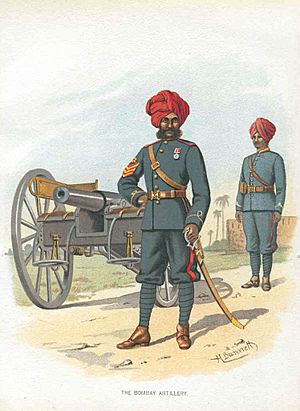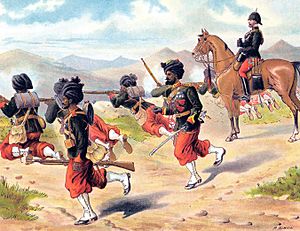Bombay Army facts for kids
Quick facts for kids Bombay Army |
|
|---|---|
 |
|
| Active | 1662–1895 (as the Bombay Army) 1895–1908 (as the Bombay Command of the Indian Army) |
| Size | 2,000 (1779) 44,000 (1876) |
| Garrison/HQ | Pune, Pune district |
The Bombay Army was a military force that belonged to the Bombay Presidency. This was one of the three main regions controlled by the British East India Company in British India.
It was created in 1662. The East India Company managed it until 1858. After that, the British government took direct control. On April 1, 1895, the Bombay Army became part of the new Indian Army. It was then called the Bombay Command until 1908.
Contents
The Bombay Army's Story
Early Days (1700s)
In the beginning, Bombay wasn't seen as a very important or healthy place. Because of this, only a small number of soldiers were kept there. The main focus was on building a local navy, called the "Bombay Marine." This navy helped to stop pirates.
By 1742, the Bombay Army had about 1,593 soldiers. These soldiers were a mix of European and Eurasian troops. They had grown from smaller groups that started as early as 1668. That's when the East India Company first took control of Bombay.
Many Mahar people joined both the Bombay Army and its navy. Before the Indian Rebellion of 1857, a large number of them were recruited. They made up about a quarter of the entire Bombay Army.
By 1783, the Bombay Army had grown to 15,000 men. This was still smaller than the other two armies in British India. From the 1750s, more local Indian soldiers, called sepoys, joined. The first regular sepoy groups were formed in 1768.
In 1796, the Indian infantry units were reorganized into four regiments. Each regiment had two battalions. The Bombay Foot Artillery, which was much older, grew to six companies by 1797.
The Bombay Army played a big part in the First Maratha War. They also helped defeat Tipu Sultan of Mysore in 1799.
The 1800s
Before the East India Company's rule ended in 1861, the Bombay Army was involved in many important battles. These included:
- The Bani Bu Ali expedition in 1821.
- The 1st Afghan War (1838–1842).
- The Sind War (1843).
- The 2nd Sikh War (1848–49).
- The Persian War of 1856-57.
The Bombay Army was also responsible for guarding Aden. In 1839, several Bombay units served there.
By 1842, the Bombay Army was spread out in different areas. These included:
- The Bombay Garrison.
- The Poona Division.
- The Northern Division.
- The Mhow Brigade.
- The Scinde Field Force.
- Forces in Lower Scinde.
- Forces guarding the Asirgarh Fort.
- Forces near Kharg Island in the Persian Gulf.
- Forces in Aden.
The number of Bombay Indian infantry regiments kept growing. By 1845, there were 26 regiments. Three Bombay Light Cavalry regiments were also formed after 1817. There was also a brigade of Bombay Horse Artillery. This group had both British and Indian soldiers.
The Bombay Army also had regular British Army regiments helping them. In 1842, one cavalry and four infantry regiments were part of the "Bombay Establishment."
The Indian Rebellion of 1857 mostly affected the Bengal Army. Out of 32 Bombay infantry regiments, only two rebelled. After some worry about the loyalty of the other units, most British troops from Bombay were sent to help in Bengal. The Bombay Indian (sepoy) and cavalry (sowar) units guarded the southern parts of the North-West Frontier. Some Bombay units also fought to stop the rebellion in Central India.
After the Rebellion
After the British government took over from the East India Company in 1861, the Bombay Army changed. Three regiments of Bombay Indian Infantry were disbanded. New units were recruited from the Beluchi population. These three "Belooch" regiments, known for their red trousers, remained a key part of the Bombay Army.
By 1864, the Bombay Army was organized into different divisions:
- The Northern Division.
- The Poona Division.
- The Mhow Division.
- The Scinde Division.
They also had smaller groups (brigades) in places like Bombay, Belgaum, and Aden. Later in the 1800s, Bombay Army units fought in:
- The 1868 Expedition to Abyssinia.
- The Second Afghan War (1878–80).
- The Third Anglo-Burmese War (1885–87).
In 1895, the three separate armies (Bombay, Madras, and Bengal) were combined. The Army of India was then divided into four main commands. Bombay (including Aden) was one of these commands.
End of the Separate Bombay Army
The process of combining the three armies started in 1895. By 1903, the regiments from the Bombay, Madras, and Bengal Armies were all numbered together. Their old regional names disappeared.
Uniforms
The Bombay Indian infantry regiments usually followed British army uniform rules. Before 1856, officers wore special coats with gold lace and tall hats. After January 1856, they started wearing tunics. These tunics were scarlet (bright red) with light yellow parts and gold braid.
After the army was reorganized in 1861, many Bombay Indian Infantry regiments became rifle regiments. They then wore green uniforms with red parts. You can see some of these old uniforms and sketches at the National Army Museum.
Units of the Bombay Army

In 1864, here are some of the units that were part of the Bombay Army:
- Bombay Artillery* – Headquarters in Kirkee.
- 1st Battalion (formed 1769)
- 2nd Battalion (formed 1820)
- 3rd (Reserve) Battalion (formed 1857)
- Corps of Royal Engineers* – Headquarters in Poona.
- Corps of Sappers and Miners* – Headquarters in Poona.
- 1st Company – Mhow
- 2nd Company – Carwar
- 3rd Company – Carwar
- 4th Company – Aden
- 5th Company – Aden
- Native Cavalry*
- 1st Light Cavalry (Lancers) – Deesa
- 2nd Light Cavalry – Neemuch
- 3rd Light Cavalry – Poona
- Poona Horse – Seroor
- 1st Regiment Scinde Horse – Jacobabad
- 2nd Regiment Scinde Horse – Jacobabad
- 3rd Regiment Scinde Horse – Jacobabad
- Southern Mahratta Horse – Kulladghee
- Native Infantry*
- 1st or Grenadier Native Infantry Regiment – Aden
- 2nd or Grenadier Native Infantry Regiment – Belgaum
- 3rd Native Infantry Regiment – Malligaum
- 4th Native Infantry Regiment (Rifle Corps) – Bombay
- 5th Light Infantry – Belgaum
- 6th Native Infantry – Mhow
- 7th Native Infantry – Poona
- 8th Native Infantry – Neemuch
- 9th Native Infantry – Dhoolia
- 10th Native Infantry – Poona
- 11th Native Infantry – Deesa
- 12th Native Infantry – Surat
- 13th Native Infantry – Ahmedabad
- 14th Native Infantry – Ahmedabad
- 15th Native Infantry – Mhow
- 16th Native Infantry – Rajkota
- 17th Native Infantry – Nusseerabad
- 18th Native Infantry – Bhooj
- 19th Native Infantry – Baroda
- 20th Native Infantry – Ahmedabad
- 21st Native Infantry or Marine Battalion – Bombay
- 22nd Native Infantry – China
- 23rd Native Infantry – Kurrachee
- 24th Native Infantry – Dharwar
- 25th Native Infantry – Bholapore
- 26th Native Infantry – Kolapore
- 27th Native Infantry or 1st Belooch Regiment – Hyderabad
- 28th Native Infantry – Mehdipore
- 29th Native Infantry or 2nd Belooch Regiment – China
- 30th Native Infantry or Jacob's Rifles – Jacobabad
Some famous units of the Bombay Army include the 1st Bombay Grenadiers (now called The Grenadiers), formed in 1784, and the Maratha Light Infantry.
Commanders of the Bombay Army
Here are some of the important leaders who commanded the Bombay Army:
- Brigadier-General Lawrence Nilson (1785–1788)
- Major-General William Medows (1788–1790)
- Major-General Robert Abercromby (1790–1793)
- Major-General James Stuart (1797–1800)
- Major-General Oliver Nicolls (1801–1808)
- Lieutenant-General John Abercromby (1809–1813)
- Lieutenant-General Sir Miles Nightingall (1816–1819)
- Lieutenant-General Sir Charles Colville (1819–1826)
- Lieutenant-General Sir Thomas Bradford (1826–1829)
- Lieutenant-General Sir Thomas Beckwith (1829–1832)
- Lieutenant-General Sir Colin Halkett (1832–1834)
- Lieutenant-General Sir John Keane (1834–1838)
- Lieutenant-General Sir Thomas McMahon (1840–1847)
- Lieutenant-General Sir Willoughby Cotton (1847–1850)
- Lieutenant-General Sir John Grey (1850–1852)
- Lieutenant-General Lord Frederick FitzClarence (1852–1854)
- Lieutenant-General Sir Henry Somerset (1855–1860)
- Lieutenant-General Sir Hugh Rose (1860)
- Lieutenant-General Sir William Mansfield (1860–1865)
- Lieutenant-General Sir Robert Napier (1865–1869)
- Lieutenant-General Sir Augustus Spencer (1869–1874)
- Lieutenant-General Sir Charles Staveley (1874–1878)
- Lieutenant-General Sir Henry Warre (1878–1881)
- Lieutenant-General Sir Arthur Hardinge (1881–1886)
- Lieutenant-General Sir Charles Arbuthnot (1886)
- Lieutenant-General The Duke of Connaught (1886–1890)
- Lieutenant-General Sir George Greaves (1890–1893)
- Lieutenant-General Sir John Hudson (1893)
- Lieutenant-General Sir Charles Nairne (1893–1895)
- Commanders-in-Chief, Bombay Command*
- Lieutenant-General Sir Charles Nairne (1895–1898)
- Lieutenant-General Sir Robert Low (1898–1903)
- Lieutenant-General Sir Archibald Hunter (1903–1907)
See Also
- Presidency armies
- Bengal Army
- Madras Army
- The Grenadiers
- Baloch Regiment





